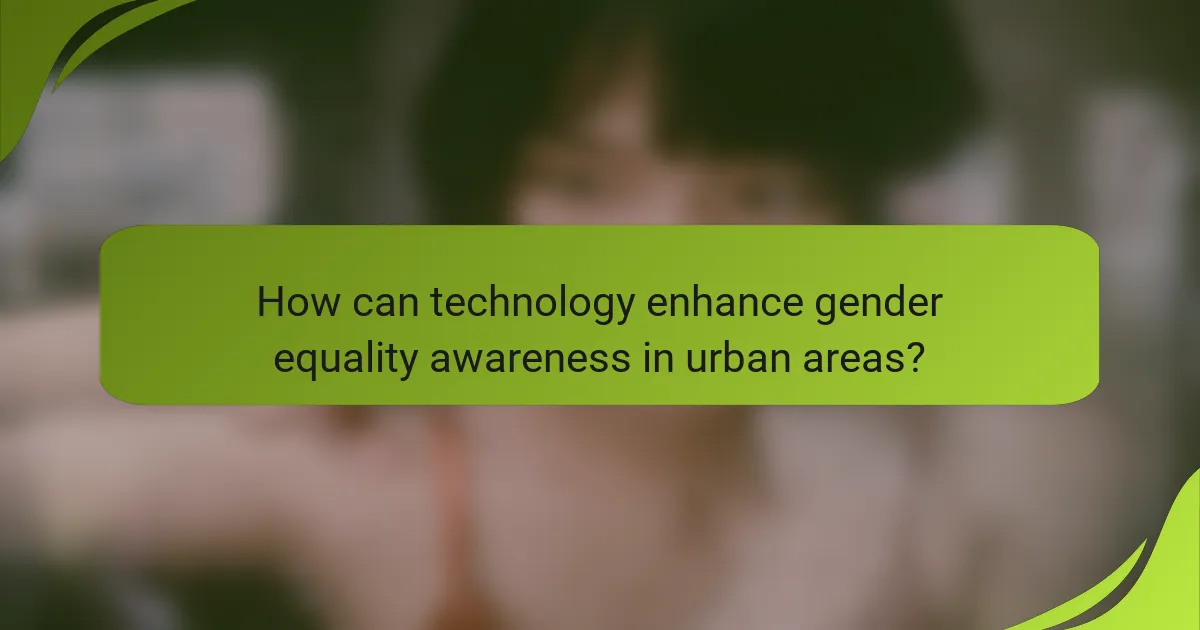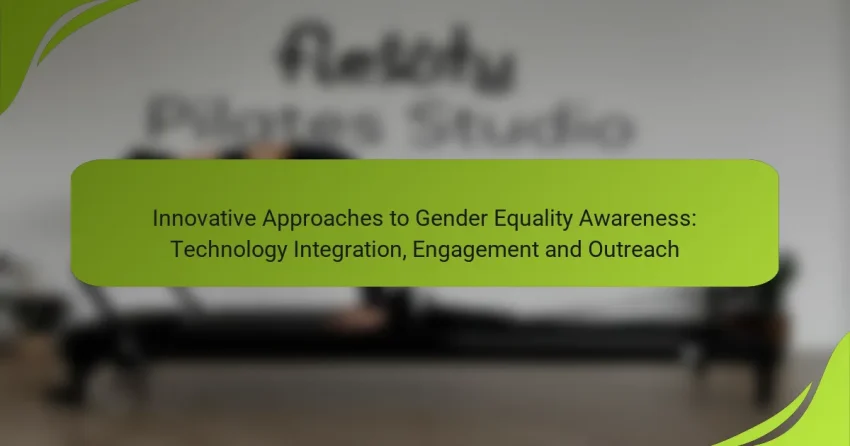Innovative approaches to gender equality awareness leverage technology to create accessible platforms for education and community engagement. By utilizing digital tools and interactive strategies, these initiatives foster discussions and mobilize support, ensuring that diverse audiences are reached and empowered to participate in the conversation around gender equality.

How can technology enhance gender equality awareness in urban areas?
Technology can significantly enhance gender equality awareness in urban areas by providing accessible platforms for education, engagement, and outreach. Through various digital tools, communities can share information, foster discussions, and mobilize support for gender equality initiatives.
Mobile applications for education
Mobile applications serve as powerful tools for educating users about gender equality issues. Apps can offer interactive content, quizzes, and resources that raise awareness and provide actionable steps for individuals to support gender equality in their communities.
For example, apps like “She Leads” or “Gender Equality Toolkit” provide users with information on local laws, resources, and organizations dedicated to gender rights. These applications can be designed to target specific urban demographics, ensuring relevance and engagement.
Social media campaigns
Social media campaigns are effective for spreading awareness about gender equality in urban settings. Platforms like Instagram, Twitter, and Facebook allow organizations to reach a broad audience quickly, using visuals and storytelling to engage users.
Successful campaigns often utilize hashtags to create movements, such as #MeToo or #HeForShe, encouraging users to share their experiences and support. Urban areas can leverage local influencers to amplify these messages, making them more relatable and impactful.
Data analytics for outreach
Data analytics can enhance outreach efforts by identifying trends and gaps in gender equality awareness. By analyzing demographic data, organizations can tailor their campaigns to address specific needs and concerns within urban populations.
For instance, using analytics tools, a nonprofit might discover that young women in a particular neighborhood are less aware of available resources. This insight allows for targeted educational initiatives, ensuring that outreach efforts are both efficient and effective.

What are effective engagement strategies for promoting gender equality?
Effective engagement strategies for promoting gender equality include community workshops, partnerships with local organizations, and interactive online platforms. These approaches foster awareness, encourage participation, and create a supportive environment for discussions around gender equality.
Community workshops
Community workshops serve as a hands-on approach to engage individuals in discussions about gender equality. These sessions can be tailored to address specific local issues, allowing participants to share experiences and brainstorm solutions.
Consider organizing workshops that include interactive activities, such as role-playing scenarios or group discussions. This can enhance understanding and empathy among participants, making the topic more relatable and actionable.
Partnerships with local organizations
Forming partnerships with local organizations can amplify efforts to promote gender equality. Collaborating with NGOs, schools, and businesses can provide additional resources and expertise, creating a more robust outreach strategy.
When establishing partnerships, focus on aligning goals and objectives. Joint events, campaigns, or educational programs can leverage each partner’s strengths, increasing visibility and impact within the community.
Interactive online platforms
Interactive online platforms are essential for reaching wider audiences and facilitating ongoing discussions about gender equality. These platforms can include social media campaigns, webinars, and dedicated forums that encourage participation from diverse groups.
To maximize engagement, utilize multimedia content such as videos, infographics, and polls. This not only makes the information more accessible but also encourages users to share their thoughts and experiences, fostering a sense of community online.

How can outreach initiatives be improved for better gender equality impact?
Outreach initiatives can be enhanced by focusing on targeted messaging, leveraging influencers, and implementing effective feedback mechanisms. These strategies ensure that gender equality campaigns resonate with diverse audiences and foster meaningful engagement.
Targeted messaging
Targeted messaging involves crafting communication that speaks directly to specific demographics. By understanding the unique challenges faced by different groups, organizations can tailor their messages to address these issues effectively.
For instance, campaigns aimed at young women may focus on education and career opportunities, while those targeting older generations might emphasize health and social support. Utilizing data analytics can help identify the most effective channels and formats for these messages.
Utilizing influencers
Engaging influencers can significantly amplify outreach efforts for gender equality. Influencers have established trust and credibility with their followers, making them powerful allies in spreading awareness and encouraging action.
Collaborating with influencers who are passionate about gender issues can help reach wider audiences. For example, a campaign could partner with a popular social media figure to share personal stories or promote events, thereby increasing visibility and engagement.
Feedback mechanisms
Implementing feedback mechanisms is essential for assessing the effectiveness of outreach initiatives. Gathering input from participants allows organizations to understand what resonates and what needs improvement.
Surveys, focus groups, and social media polls can provide valuable insights. Regularly reviewing this feedback helps refine strategies and ensures that outreach efforts remain relevant and impactful in promoting gender equality.

What criteria should be considered when selecting technology for gender equality initiatives?
When selecting technology for gender equality initiatives, it is crucial to consider user accessibility, scalability of solutions, and cost-effectiveness. These criteria ensure that the technology effectively reaches and engages the target audience while remaining sustainable and affordable.
User accessibility
User accessibility is essential for ensuring that all individuals, regardless of their abilities or backgrounds, can engage with the technology. This includes considering features such as language options, screen reader compatibility, and mobile responsiveness. For instance, platforms that offer multilingual support can reach a broader audience in diverse communities.
Additionally, it’s important to conduct user testing with various demographic groups to identify any barriers to access. Ensuring that the technology is easy to navigate can significantly enhance user experience and participation in gender equality initiatives.
Scalability of solutions
Scalability refers to the ability of a technology solution to grow and adapt as the initiative expands. When selecting technology, consider whether it can handle increased user numbers and additional features without compromising performance. Solutions that are cloud-based often provide better scalability, allowing for seamless updates and increased storage capacity.
For example, a platform that initially serves a small community can be expanded to accommodate a national audience without requiring a complete overhaul. This adaptability is crucial for long-term success and sustainability of gender equality programs.
Cost-effectiveness
Cost-effectiveness is a critical factor in selecting technology for gender equality initiatives, as budgets can be limited. Evaluate both the initial investment and ongoing operational costs, including maintenance and support. Open-source solutions may offer a lower cost alternative while still providing robust features.
It’s also beneficial to assess the return on investment (ROI) by considering how the technology can enhance outreach and engagement. Prioritize solutions that provide clear metrics for measuring impact, ensuring that funds are used efficiently to promote gender equality.

What are the current trends in gender equality technology integration?
Current trends in gender equality technology integration focus on leveraging innovative tools to enhance awareness and engagement. These technologies aim to promote inclusivity, transparency, and active participation in gender equality initiatives.
AI-driven solutions
AI-driven solutions are increasingly being used to analyze data related to gender disparities and to develop targeted interventions. For example, machine learning algorithms can identify patterns in hiring practices that may disadvantage women, allowing organizations to adjust their recruitment strategies accordingly.
Additionally, AI chatbots can facilitate discussions around gender equality by providing resources and support to individuals seeking information. These tools can help raise awareness and encourage dialogue in a more accessible manner.
Blockchain for transparency
Blockchain technology offers a secure and transparent way to track gender equality initiatives and funding. By utilizing blockchain, organizations can ensure that resources are allocated fairly and that progress is easily verifiable. This transparency can build trust among stakeholders and encourage greater investment in gender equality programs.
For instance, NGOs can use blockchain to document donations and expenditures related to gender equality projects, providing a clear audit trail. This can help prevent misallocation of funds and ensure that contributions are effectively used to support women’s empowerment.
Virtual reality experiences
Virtual reality (VR) experiences are being developed to immerse users in scenarios that highlight gender inequality. These simulations can foster empathy and understanding by allowing participants to experience the challenges faced by marginalized genders in various contexts, such as the workplace or educational settings.
Organizations can implement VR training programs to educate employees about gender biases and promote inclusive practices. By engaging users in a compelling way, VR can enhance awareness and motivate individuals to take action towards gender equality.

How can organizations measure the effectiveness of their gender equality programs?
Organizations can measure the effectiveness of their gender equality programs through various methods that assess both quantitative and qualitative outcomes. Key approaches include surveys, assessments, and performance metrics that gauge progress toward established goals.
Surveys and assessments
Surveys and assessments are essential tools for evaluating gender equality programs. They can provide insights into employee perceptions, experiences, and satisfaction levels regarding gender equality initiatives. Organizations should design surveys that include both closed and open-ended questions to capture a range of responses.
When conducting surveys, consider using a mix of Likert scale questions to quantify attitudes and open questions to gather detailed feedback. Aim for a response rate of at least 60% to ensure the data is representative. Regularly scheduled assessments, such as annual reviews, can help track changes over time.
To enhance the effectiveness of surveys, ensure anonymity to encourage honest feedback. Additionally, follow up with focus groups or interviews to delve deeper into survey findings, allowing for a more comprehensive understanding of the issues at hand.
